5 Brand Pitch Email Templates that Get Replies (by Use Case)
If the mountain won’t go to Mohammed, Mohammed must go to the mountain.
We believe that all influencers, no matter their size, should adopt this mentality.
Why?
Many content creators think that success and recognition will naturally come to them once they reach a certain number of followers. However, lucrative brand deals won’t just appear out of nowhere – you need to find them yourself.
One way of doing that is by pitching your offer to the brands directly. This way, you can choose collaborations that resonate with your values and your target audience’s needs.
But where should you start?
We’ve got you covered with our five brand pitch email templates you can steal.
What is a Brand Pitch Email?
A brand pitch is a cold email a creator sends to a business to convince it to partner up on a collaboration.
In other words, you, as an influencer, launch a digital PR campaign, reach out to a brand you like or think is a good fit for your followers, and ask its representatives if they are willing to run a joint campaign (e.g., on social media), for mutual promotion.
You can also use a brand pitch deck or presentation as a substitution for email, but regardless of the format you choose, it should include the following:
- An introduction describing who you are
- Some analytics and stats about what makes you stand out
- Information on your previous collaborations with brands
An influencer marketing pitch is usually short and straightforward. Its tone is sweet and inviting. However, it also highlights your strengths and experience that would convince a brand to choose you over other bloggers in your niche. On a general note, it would be very similar to what media pitch looks like.
Why should you invest time in talking to businesses through email outreach?
Here are some convincing benefits:
- Attracting new customers. No matter how big you are, you can’t expect a solid partnership to just pop up unannounced. In most cases, you will have to sort through irrelevant proposals and reach out to the right brands yourself.
- Build awareness. This one is especially true for micro-influencers with a small follower count. By pitching your offer to businesses, you let them know about what you can offer and the opportunities that open before them if they collab with you.
- Reinforce long-lasting brand-influencer relationships. Pitching is the first and essential step in helping you build a pathway to recurring partnerships and steady income.
Of course, not every pitch can be considered effective, so let’s move on to the next section and discuss three crucial factors to keep in mind if you want your email to get a positive response.
3 Factors to Pay Attention to When Writing a Brand Pitch Email
Whatever industry you work in as an influencer, there will be three constants that your pitch should rely on.
Let’s take a look at these factors, evaluate their importance, and discuss how to approach them the right way.
Factor #1: Subject line
A pitch subject line is the first text line a recipient sees after receiving your email.
Here’s what it looks like in the inbox:

A subject line plays a huge role in the success of your pitch, primarily because if written well, it can increase email open rate.
Consider this: according to HubSpot, 35% of recipients open an email based on the subject line alone. So, you can effectively lose a quarter of all opportunities you’re trying to get with an email pitching campaign if your subject line does not appeal to the recipient.
So, what goes into the formula of a subject line that your target audience will want to click on?
Here are some elements you should definitely consider:
- Personalization. According to InvespCRO, personalized subject lines are 22.2% more likely to be opened. Besides using the recipient’s first name, you can also appeal to their interests or hint at the opportunities you’re offering in an email.
- Emojis. Yes, adding a smile to your subject line is a legit practice, as companies that do so get a 56% higher open rate than those that don’t. However, it will only work if you use contextually correct emojis and don’t stuff your subject lines with them.
- A/B testing. This approach allows you to see which subject line variable your target audience will positively respond to. Including this step will help you significantly improve your pitch’s click-through rate, as it did for Skandium (the company managed to grow its CTR by 26.96% with A/B testing).
Speaking about A/B testing, there are some email marketing tools to help you with that. For instance, we have a comparison article for MailerLite vs. Mailchimp – both have the A/B testing feature.
Finally, you should follow general recommendations to help you avoid spam filters. Influential factors include your IP reputation, trigger words (e.g., extra cash, increase sales), etc.
Factor #2: Introduction
An email introduction is a part of your pitch where you will provide all essential information for the recipient to get to know you better.
This part is crucial for creator pitches, as putting it together the right way will leave a lasting positive impression on brand representatives. But here’s the thing – it can’t be too long; otherwise, it will turn your email into boring self-promotion.
So, what should you include?
Here are the essentials, plus some recommendations:
- Start with your full name and the name of your social media channel. You should begin your pitch by introducing yourself and sharing a sneak peek of your online presence. Don’t forget to mention what niche your channel belongs to. For instance, if you’re a TikTok influencer, you can share your full name plus the TikTok handle with an embedded link to your channel.
- Refer to a mutual contact. To strengthen your chances of getting a reply, you can mention a person you and the recipient know and say that this is how you learned about their brand.
- Appeal to a shared interest. This can be a recent post or a campaign the brand launched that you find exciting or anything else that might spark a conversation.
Once you introduce yourself, you can start discussing the opportunities your possible collaboration with a given brand can offer.
Tip: don’t forget to include some statistics and results of your previous collaborations as supporting evidence of your experience.
Factor #3: Media kit
An influencer media kit is a document that gives an overview of your strengths, contains proof that you have engaged followers, and highlights the value of partnering with you.
Essentially, you need this document to present your strategy to the business you want to collaborate with – you can also call it your influencer resume. Sharing it helps you appear more professional, communicate your offer more efficiently, and ultimately land better deals.
What does a media kit include?
- A bio. This introductory part should include your full name, location, and description of your personality – values, interests, and experience. Finally, a separate part of the bio should be dedicated to your channel and its direction.
- Performance statistics. This section includes your follower count, engagement metrics (reach, likes, comments, mentions, overall engagement rate, etc.), and audience demographics. Additionally, you can touch upon your weekly posting schedule, what types of posts you do and which ones perform the best, and the follower growth trend within several months.
- Case studies. Do not be shy to boast about your previous experiences with other brands. However, make sure you pick the cases from the same industry where your point of contact operates. Here, we should also add that you can include surveys of your previous clients for extra credibility.
- Visual portfolio. Here, you can add examples of your works – images, videos, etc. These examples should only be of high quality.
- Rates. This section focuses on the remuneration you expect from collaborating with a given brand name. Besides, sharing your rates upfront will help you make sure you get paid for your part of the job.
- Contact details. End your media kit presentation with contact information – your or your marketing manager’s phone number, email, website, and social pages where brand representatives can find you.
Alright, we’ve discussed the most crucial email pitch factors influencers should consider. Now, it’s time for the brand pitch templates.
Note: We don’t encourage you to copy these pitches word for word. Remember – most of your pitch’s success comes from personalization, meaning each pitch will be different depending on the brand you’re contacting.
Email Template #1: Beauty Industry
Here we have an email pitch template for beauty influencers of all levels.
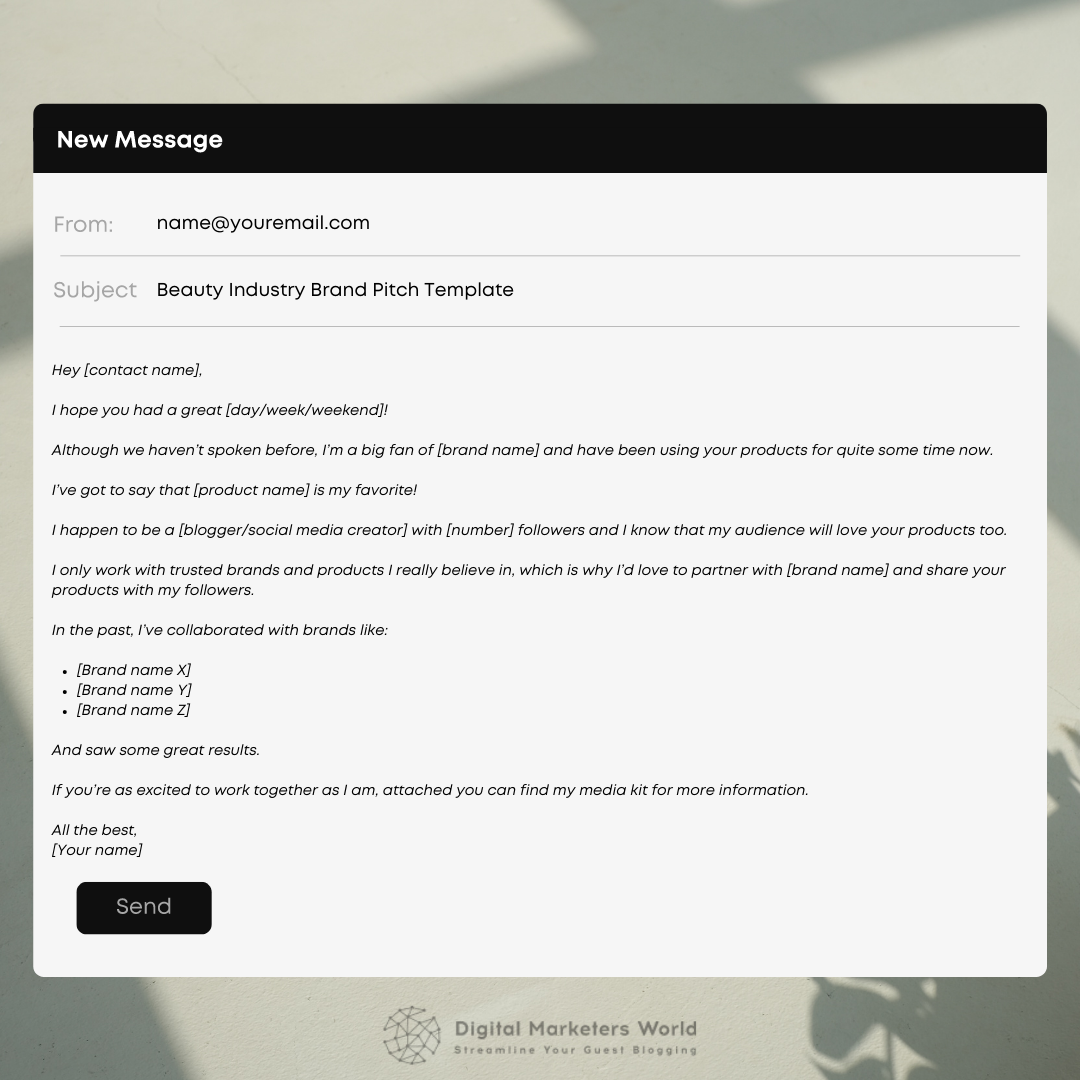
Now, let’s break it down.
This template offers the basics of what a beauty influencer can talk about in their pitch. There is a short introduction covering who you are, what your social media account is about, and how many followers it has.
Now, you can level the intro up a notch by saying that you’ve been a fan of this brand for a long time, and, as proof, you can add content pieces or videos where you used this brand’s product in your makeup tutorials. This will add credibility, showing that you’re not just brown-nosing them.
Note: don’t make the intro too long because it will deflect the main point of your pitch.
Next, you can say that you only work with trusted brands to show respect for the company you’re targeting and that you value your work. This way, you prove that you’re serious about this partnership.
Finally, you can talk about previous experiences collaborating with other beauty brands. You can simply list them (like in the template) or make a little upgrade and highlight the results for each collaboration. Don’t forget to refer the recipient to your media kit for more information.
Now, what if you’re a new influencer and have never done this before?
In this case, you can mention some general statistics of why it’s beneficial for a brand to work with an influencer. For example, if the company you’re targeting sells primarily to Gen Z, you can mention that this segment of shoppers is particularly influenced by the recommendations of beauty influencers.
On a general note, if you have no experience to share, research the company, address their needs (e.g., get more followers, potential customers, or increase conversion rate), and be specific about how a collab with you can solve them.
Email Template #2: Travel Industry
Travel influencers can reach out to hotels, resorts, booking websites, and other businesses related to the hospitality industry.
The trick with your pitch, in this case, would be to highlight the benefit of partnering on sponsored content with you for their brand and service.
Here’s what this pitch can look like:
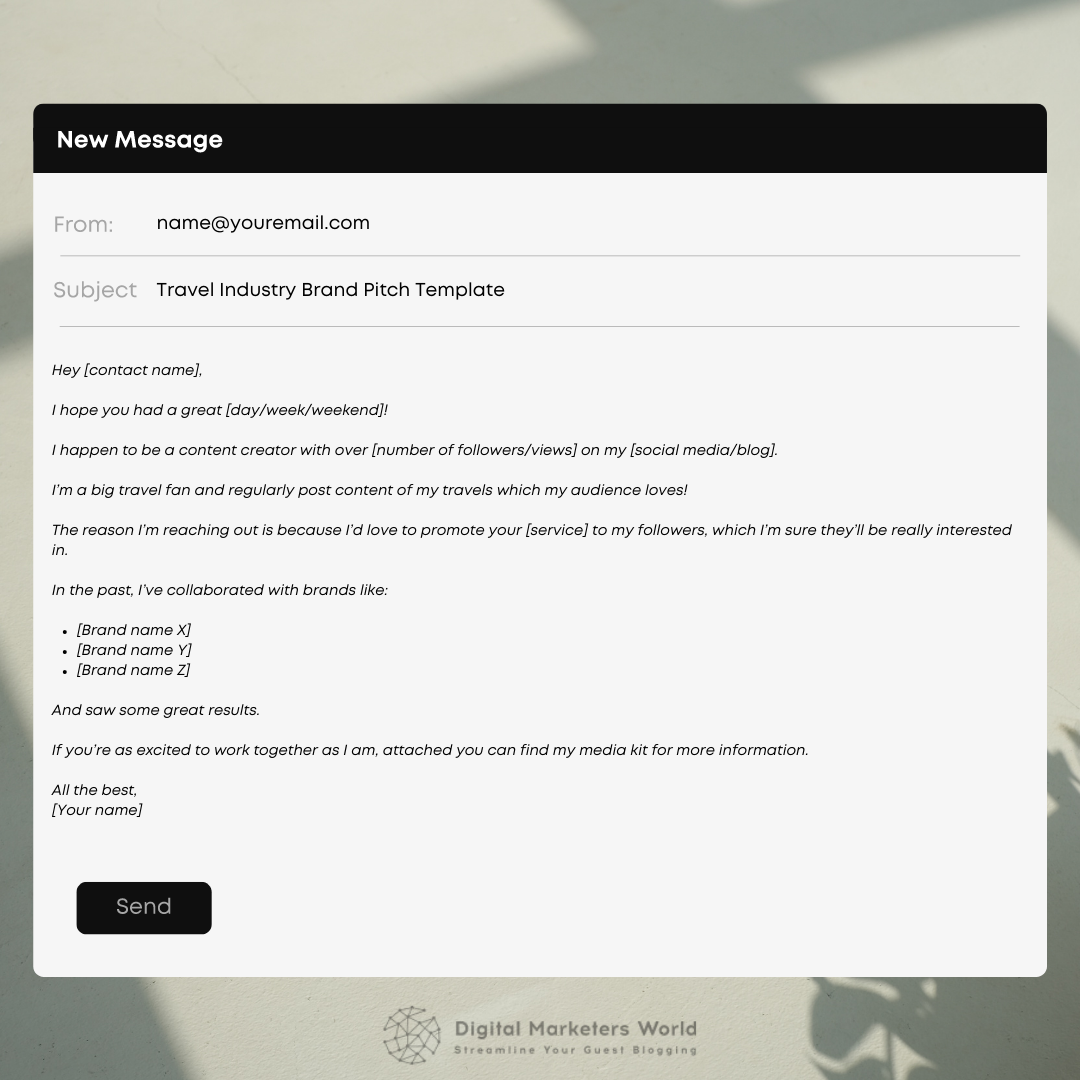
First, as usual, you should introduce yourself and tell the recipient a bit about your experience.
If you’re writing to a hotel in a particular location, you can share your experience traveling to that place – this would be the touchpoint where you and the recipient will connect. Or, if you stayed in that hotel, you can talk about how much you loved your time there and would like to give this business extra publicity.
Next, you can talk about your channel and how you usually engage with your followers. Briefly share where your subscribers come from and why they would be interested in learning more about the brand you’re contacting.
It also wouldn’t hurt to elaborate more on why a specific business would benefit from becoming business partners with you. For instance, you can study its current social media profiles and the following base, show how yours is similar, and suggest improvements your collaboration will make to its online presence.
As an example, you can show partnerships with other hotels or booking services and share the results you helped them achieve.
What if it’s your first pitch as a travel influencer?
In case you’re trying to land your first influencer marketing campaign, you can analyze the current marketing strategy of a brand you’re contacting and show them how influencers can give their marketing efforts a boost.
Email Template #3: Food Industry
The food industry, although quite big (it is projected to generate $12 trillion by 2026), still very much relies on mutual recommendations and promotions. That’s exactly what you should bet on in your brand pitch email.
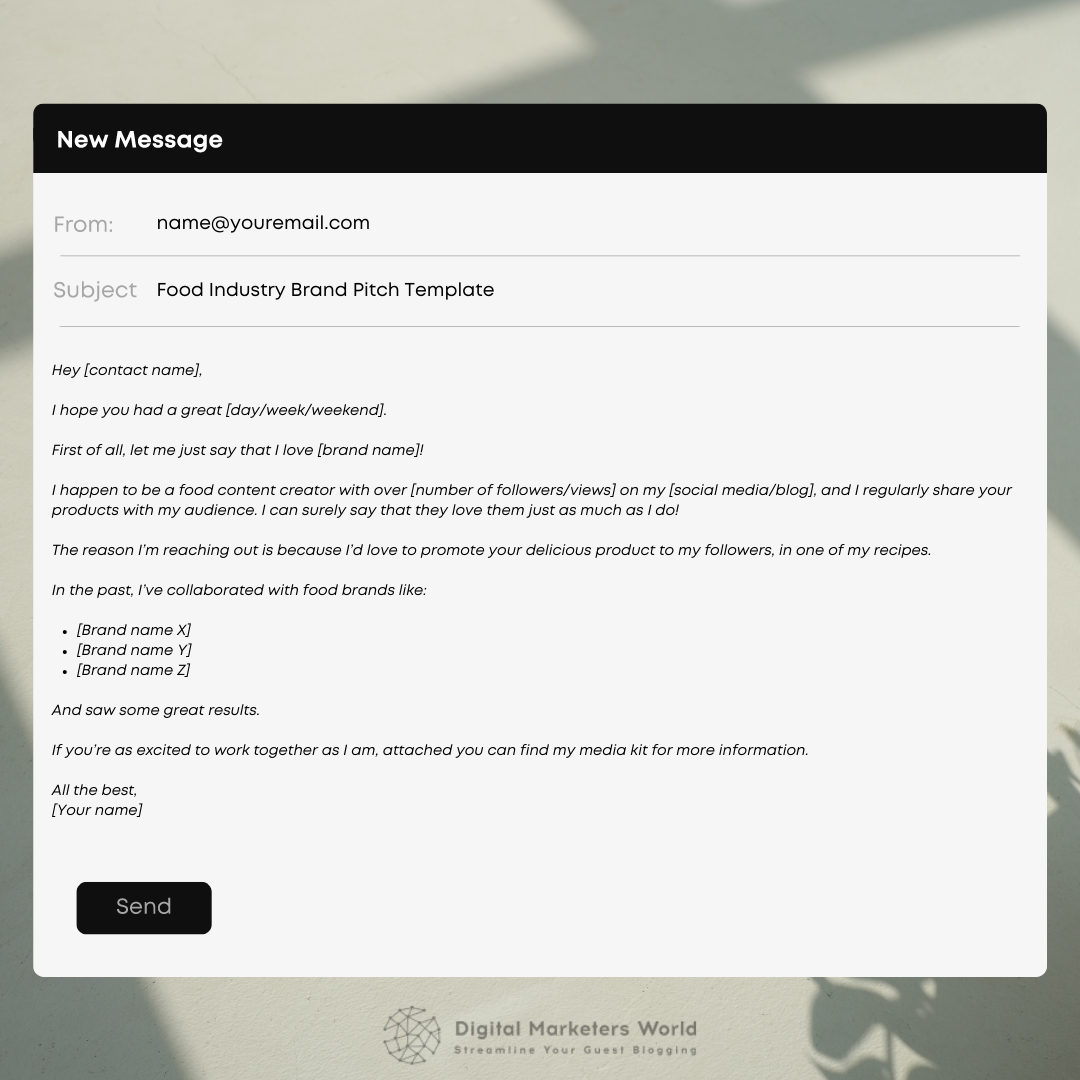
So, start your pitch with a short introduction and description of the main activities you focus on in your blog.
Next, you can either mention the shared contact that introduced you to the given brand or that you’ve used their products for a while (e.g., in your recipes) and loved their quality. Either way, you want to show that you’re familiar with this business and recognize the value of its products.
You can continue your pitch by offering the format of your influencer-brand collaboration. For example, if you’re an Instagram influencer, you can make a short video with a recipe only using the brand’s products. If you’re contacting a catering service, you can suggest creating content where you experiment with the recipes from its delivery kits.
To support your suggestion, show examples of your previous collabs and their formats. Don’t forget to touch upon the results these partnerships achieved.
Note: your media kit should bet heavily on visual content, especially if you’ve just become an influencer. The food industry is all about visuals, and high-quality shots alone can already land you a much-desired campaign with your dream brand.
Email Template #4: Fitness Industry
The fitness industry prefers influencer marketing over traditional marketing.
A good example to prove that is Gymshark.
A couple of years ago, this brand launched a TikTok campaign engaging different creators promoting its products. These joint efforts turned into a TikTok trend with its own hashtag #gymshark66.
The results?
The sales for Gymshark’s products increased by 150% year-on-year in July and August 2020.
So, knowing the value you as a creator can bring to a fitness brand, you can absolutely try and pitch your services.
Here’s a template of an email you can send:
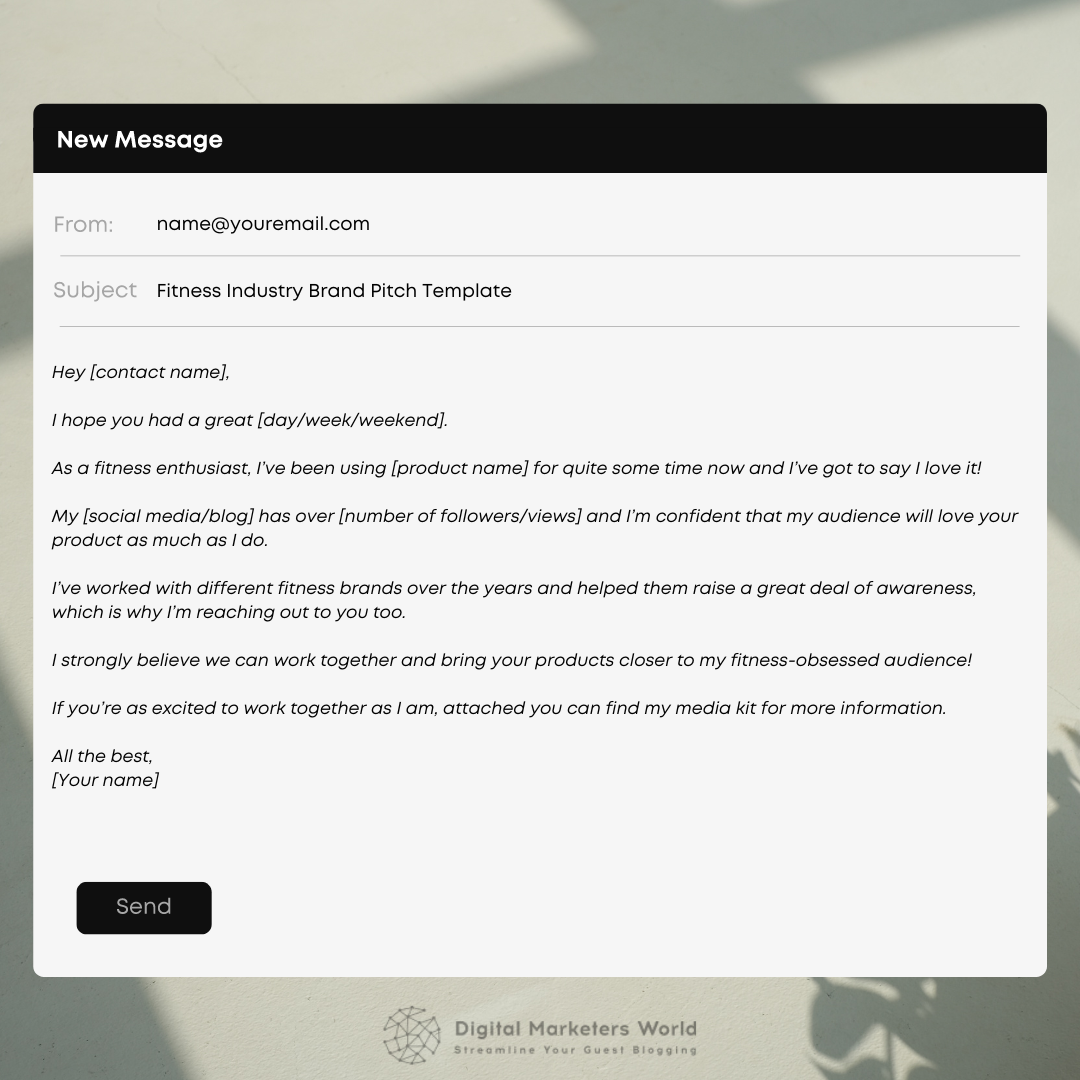
This pitch starts the same way as our previous examples – with a brief introduction and a short description of your online activity.
Next, you want to highlight that the brand’s product resonates with your audience, but you should also explain why. For instance, maybe you’ve used it in your workouts or recommended it to your followers before. Either way, it would be good to show some stats confirming that your audience matches this business and its products.
Apart from that, since the fitness industry is very competitive, you want to go heavy on examples of your previous collaborations. Discuss these partnerships in detail, explain the format they followed (e.g., gifting free products, giveaway, Instagram Stories), and describe the results.
Finally, conclude with some specific insights into how the brand you’re contacting will benefit from working with you. For instance, you can help them raise awareness or expand their reach compared to what they have now.
You want to sound as convincing as possible, so make sure to do thorough research.
Email Template #5: Follow-up
Finally, if you don’t receive a reply to your initial pitch, you can send a follow-up email.
It might look something like this:
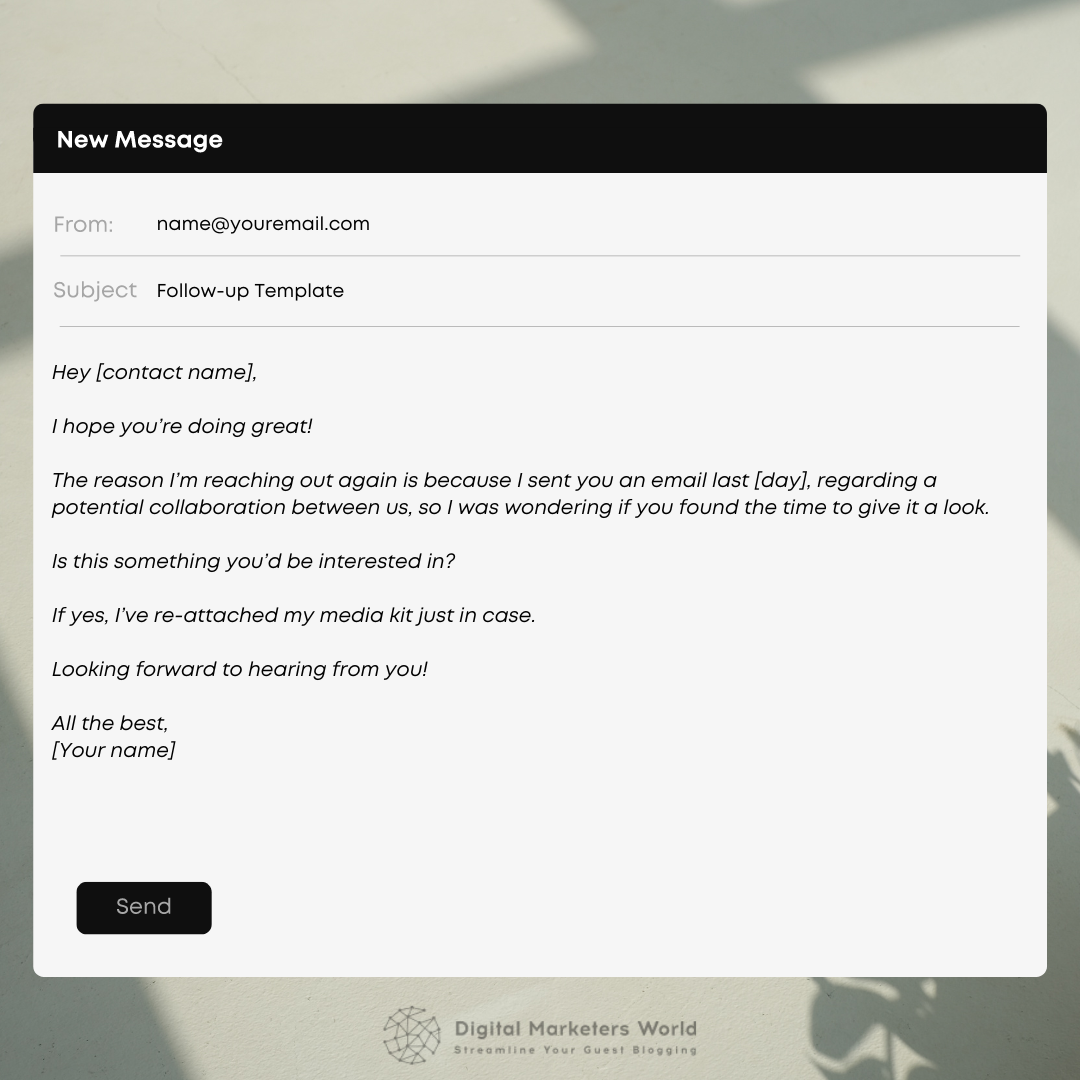
Now let’s talk more about what to do and what not to do in such emails.
First of all, you want to provide context to refresh the recipient’s memory about the topic of your first pitch. Remember – brands receive tons of collab propositions every day, so it’s natural if yours gets lost in the shuffle.
Next, consider offering additional value and incorporating it into your follow-up. For example, you can make projections of what the business’s social media following would look like if they partner on a campaign with you.
Finally, you want to reattach your email branding media kit to make sure the recipient has all the resources to learn more about you.
Also, make sure to avoid these mistakes so that your pitch doesn’t go straight into the Trash folder:
- Not including a CTA. A call to action helps the recipient understand what to do next. Be sure to make your CTA specific. What should the brand representative do? Call? Email back?
- Making your follow-up too long. Like your pitch, the follow-up email should be short and sweet. Remember, the recipient can find all the additional information in the media kit, so there’s no need to duplicate it in the body of the email.
- Bombarding the brand with follow-ups. The most optimal number of such emails is two or three. Also, don’t wait with this message too long – you can send a reminder after three or four days if no one responds.
Note: if you don’t receive any response, you should also check if you’ve contacted the right person. However, if you can’t find the right contact, ask the recipient to refer you to someone who does brand partnerships for the company. Another option is researching the company name via LinkedIn.
Now Over to You
This wraps up our guide on brand email pitches for influencers.
You can use these templates to guide you, but remember that personalization is key. Study every brand you’re contacting, research their needs, figure out how you can cater to them, and build your pitch around that.
Will you succeed on the first try?
Maybe not, but pitching your offers is the only way to grow your business and improve personal brand recognition. No matter how time-consuming it turns out to be, don’t give up on email pitches right away. Instead, try to understand how to make them more convincing.
We have many other resources for influencers on our blog – make sure to check them out!

Mariia is a content strategist and editor at Digital Marketer’s World. She is passionate about educating others on all things marketing and believes in the power of the written word.
